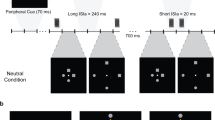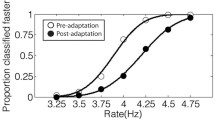Abstract
The coupling between sensory and motor processes has been established in various scenarios: for example, the perception of auditory rhythm entails an audiomotor representation of the sounds. Similarly, visual action patterns can also be represented via a visuomotor transformation. In this study, we tested the hypothesis that the visual motor information, such as embedded in a coherent motion flow, can interact with the perception of a motor-related aspect in auditory rhythm: the tempo. In the first two experiments, we employed an auditory tempo judgment task where participants listened to a standard auditory sequence while concurrently watching visual stimuli of different motion information, after which they judged the tempo of a comparison sequence related to the standard. In Experiment 1, we found that the same auditory tempo was perceived as faster when it was accompanied by accelerating visual motion than by non-motion luminance change. In Experiment 2, we compared the perceived auditory tempo among three visual motion conditions, increase in speed, decrease in speed, and no speed change, and found the corresponding bias in judgment of auditory tempo: faster than it was, slower than it was, and no bias. In Experiment 3, the perceptual bias induced by the change in motion speed was consistently reflected in the tempo reproduction task. Taken together, these results indicate that between a visual spatiotemporal and an auditory temporal stimulation, the embedded motor representations from each can interact across modalities, leading to a spatial-to-temporal bias. This suggests that the perceptual process in one modality can incorporate concurrent motor information from cross-modal sensory inputs to form a coherent experience.







Similar content being viewed by others
Notes
In order to facilitate the percept of forward motion, during instruction the experimenter mentioned that the appearance of motion condition might resemble that of the situation while they were sitting in a forward-moving car, with the scenes outside moving towards them. All participants were able to relate to this sensation while watching visual motion stimuli.
When a mean ITI exceeded three standard deviations from the average of mean ITIs under the same condition, the trial was excluded from the analysis. The occurrence of exclusion was generally very low, never exceeding 2% in any participant.
References
Alais D, Burr D (2004) The ventriloquist effect results from near-optimal bimodal integration. Curr Biol 14:257–262
Alink A, Singer W, Muckli L (2008) Capture of auditory motion by vision is represented by an activation shift from auditory to visual motion cortex. J Neurosci 28:2690–2697
Bengtsson SL, Ullen F, Ehrsson HH, Hashimoto T, Kito T, Naito E, Forssberg H, Sadato N (2009) Listening to rhythms activates motor and premotor cortices. Cortex 45:62–71
Brainard DH (1997) The psychophysics toolbox. Spat Vis 10:433–436
Brandon M, Saffran JR (2011) Apparent motion enhances visual rhythm discrimination in infancy. Atten Percept Psychophys. doi:10.3758/s13414-011-0106-x
Buhusi C, Meck WH (2005) What makes us tick? Functional and neural mechanisms of interval timing. Nat Rev Neurosci 6:755–765
Burr D, Banks M, Morrone M (2009) Auditory dominance over vision in the perception of interval duration. Exp Brain Res 198:49–57
Chapin HL, Zanto T, Jantzen KJ, Kelso SJA, Steinberg F, Large EW (2010) Neural response to complex auditory rhythms: the role of attending. Front Psychol 1:1–18
Chen JL, Penhune VB, Zatorre RJ (2008) Listening to musical rhythms recruits motor regions of the brain. Cereb Cortex 18:2844–2854
Chen JL, Penhune VB, Zatorre RJ (2009) The role of auditory and premotor cortex in sensorimotor transformations. Ann NY Acad Sci 1169:15–34
Drake C, Botte MC (1993) Tempo sensitivity in auditory sequences: evidence for a multi-look model. Percept Psychophys 54:277–286
Drake C, Jones MR, Baruch C (2000) The development of rhythmic attending in auditory sequences: attunement, referent period, focal attending. Cognition 77:251–288
Droit-Volet S, Wearden JH (2002) Speeding up an internal clock in children? Effects of visual flicker on subjective duration. Q J Exp Psychol B 55:193–211
Fadiga L, Fogassi L, Gallese V, Rizzolatti G (2000) Visuomotor neurons: ambiguity of the discharge or ‘motor’ perception? Int J Psychophysiol 35:165–177
Fendrich R, Corballis PM (2001) The temporal cross-capture of audition and vision. Percept Psychophys 63:719–725
Fraisse P (1963) Psychology of time. Harper & Row, New York
Fries P, Reynolds JH, Rorie AE, Desimone R (2001) Modulation of oscillatory neuronal synchronization by selective visual attention. Science 291:1560–1563
Grahn JA, Brett M (2007) Rhythm and beat perception in motor areas of the brain. J Cogn Neurosci 19:893–906
Grahn JA, Rowe JB (2009) Feeling the beat: premotor and striatal interactions in musicians and nonmusicians during beat perception. J Neurosci 29:7540–7548
Grahn JA, Henry MJ, McAuley JD (2010) FMRI investigation of cross-modal interactions in beat perception: audition primes vision, but not vice versa. Neuroimage. doi:10.1016/j.neuroimage.2010.09.033
Grondin S, McAuley D (2009) Duration discrimination in crossmodal sequences. Perception 38:1542–1559
Guttman SE, Gilroy LA, Blake R (2005) Hearing what the eyes see: auditory encoding of visual temporal sequences. Psychol Sci 16:228–265
Hoshi E, Tanji J (2006) Differential involvement of neurons in the dorsal and ventral premotor cortex during processing of visual signals for action planning. J Neurophysiol 95:3596–3616
Hove MJ, Spivey MJ, Krumhansl CL (2010) Compatibility of motion facilitates visuomotor synchronization. J Exp Psychol Hum Percept Perform 36:1525–1534
Iversen JR, Repp BH, Patel AD (2009) Top-down control of rhythm perception modulates early auditory responses. Ann NY Acad Sci 1169:58–73
Jones MR, Boltz M (1989) Dynamic attending and responses to time. Psychol Rev 96:459–491
Jones MR, McAuley JD (2005) Time judgments in global temporal contexts. Percept Psychophys 67:398–417
Kanai R, Paffen CL, Gerbino W, Verstraten FA (2004) Blindness to inconsistent local signals in motion transparency from oscillating dots. Vision Res 44:2207–2212
Kanai R, Paffen CLE, Hogendoorn H, Verstraten FAJ (2006) Time dilation in dynamic visual display. J Vis 9:1421–1430. doi:10.1167/6.12.8
Kaneko S, Murakami I (2009) Perceived duration of visual motion increases with speed. J Vis 9:1–12. doi:10.1167/9.7.14
Karabanov A, Blom Ö, Forsman L, Ullén F (2009) The dorsal auditory pathway is involved in performance of both visual and auditory rhythms. Neuroimage 44:480–488
Kitagawa N, Ichihara S (2002) Hearing visual motion in depth. Nature 416:172–174
Kohler E, Keysers C, Umiltà MA, Fogassi L, Gallese V, Rizzolatti G (2002) Hearing sounds, understanding actions: action representation in mirror neurons. Science 297:846–848
Kornysheva K, von Cramon DY, Jacobsen T, Schubotz RI (2010) Tuning-into the beat: aesthetic appreciation of musical rhythms correlates with a premotor activity boost. Hum Brain Mapp 31:48–64
Kovács G, Raabe M, Greenlee MW (2008) Neural correlates of visually induced self-motion illusion in depth. Cereb Cortex 18:1779–1787
Lahav A, Saltzman E, Schlaug G (2007) Action representation of sound: audiomotor recognition network while listening to newly acquired actions. J Neurosci 27:308–314
Lakatos P, Karmos G, Mehta AD, Ulbert I, Schroeder CE (2008) Entrainment of neuronal oscillations as a mechanism of attentional selection. Science 320:110–113
Large EW (2008) Resonating to musical rhythm: theory and experiment. In: Grondin S (ed) The psychology of time. Emerald, UK, pp 189–231
Large EW, Snyder JS (2009) Pulse and meter as neural resonance. Ann NY Acad Sci 1169:46–57
Lee J, van Donkelaar P (2006) The human dorsal premotor cortex generates on-line error corrections during sensorimotor adaptation. J Neurosci 26:3330–3334
Lewald J, Guski R (2003) Cross-modal perceptual integration of spatially and temporally disparate auditory and visual stimuli. Cogn Brain Res 16:468–478
Matthews WJ (2011) How do changes in speed affect the perception of duration? J Exp Psychol Human. doi:10.1037/a0022193
McAuley JD, Henry MJ (2010) Modality effects in rhythm processing: auditory encoding of visual rhythms is neither obligatory nor automatic. Atten Percept Psychophys 72:1377–1389
McAuley JD, Jones MR (2003) Modeling effects of rhythmic context on perceived duration: comparison of interval and entrainment approaches to short-interval timing. J Exp Psychol Hum 29:1102–1125
McAuley JD, Miller NS (2007) Effects of global temporal context on sensitivity to the tempo of auditory sequences. Percept Psychophys 69:709–718
Merker BH, Madison GS, Eckerdal P (2009) On the role and origin of isochrony in human rhythmic entrainment. Cortex 45:4–17
Miller NS, McAuley JD (2005) Tempo sensitivity in isochronous tone sequences: the multiple-look model revisited. Percept Psychophys 67:1150–1160
Morein-Zamir S, Soto-Faraco S, Kingston A (2003) Auditory capture of vision: examining temporal ventriloquism. Cogn Brain Res 17:154–163
Murata A, Fadiga L, Fogassi L, Gallese V, Raos V, Rizzolatti G (1997) Object representation in the ventral premotor cortex (area F5) of the monkey. J Neurophysiol 78:2226–2230
Patel AD, Iversen JR, Chen Y, Repp BH (2005) The influence of metricality and modality on synchronization with a beat. Exp Brain Res 163:226–238
Pilgramm S, Lorey B, Stark R, Munzert J, Vaitl D, Zentgraf K (2010) Differential activation of the lateral premotor cortex during action observation. BMC Neurosci 11:89. doi:10.1186/1471-2202-11-89
Prinz W (1997) Perception and action planning. Eur J Cogn Psychol 9:129–154
Recanzone GH (2003) Auditory influences on visual temporal rate perception. J Neurophysiol 89:1078–1093
Repp BH (2003) Rate limits in sensorimotor synchronization with auditory and visual sequences: the synchronization threshold and the benefits and costs of interval subdivision. J Mot Behav 35:355–370
Repp BH (2008) Metrical subdivision results in subjective slowing of the beat. Music Percept 26:19–39
Repp BH, Bruttomesso M (2009) A filled duration illusion in music: effects of metrical subdivision on the perception and production of beat tempo. Adv Cogn Psychol 5:114–134
Repp BH, Penel A (2002) Auditory dominance in temporal processing: new evidence from synchronization with simultaneous visual and auditory sequences. J Exp Psychol Hum Percept Perform 28:1085–1099
Rizzolatti G, Fadiga L, Gallesi V, Fogassi L (1996) Premotor cortex and the recognition of motor actions. Brain Res Cogn Brain Res 3:131–141
Scheef L, Boecker H, Daamen M, Fehse U, Landsberg MW, Granath DO, Mechling H, Effenberg AO (2009) Multimodal motion processing in area V5/MT: evidence from an artificial class of audio-visual events. Brain Res 1252:94–104
Schmidt RC, Richardson MJ, Arsenault C, Galantucci B (2007) Visual tracking and entrainment to an environmental rhythm. J Exp Psychol Human 33:860–870
Shams L, Kamitani Y, Shimojo S (2000) Illusions. What you see is what you hear. Nature 408:788
Shams L, Ma WJ, Beierholm U (2005) Sound-induced flash illusion as an optimal percept. Neuroreport 16:1923–1927
Shipley T (1964) Auditory flutter-driving of visual flicker. Science 145:1328–1330
Soto-Faraco S, Lyons J, Gazzaniga M, Spence C, Kingston A (2002) The ventriloquist in motion: illusory capture of dynamic information across sensory modalities. Cogn Brain Res 14:139–146
Todd NPM (1999) Motion in music: a neurobiological perspective. Music Percept 17:115–126
Todd NPM, Lee CS, O’Boyle DJ (2002) A sensorimotor theory of temporal tracking and beat induction. Psychol Res 66:26–39
Treisman M, Faulkner A, Naish PLN, Brogan D (1990) The internal clock: evidence for a temporal oscillator underlying time perception with some estimates of its characteristic frequency. Perception 19:705–743
Tse PU, Intriligator J, Rivest J, Cavanagh P (2004) Attention and the subjective expansion of time. Percept Psychophys 66:1171–1189
van der Hoorn A, Beudel M, de Jong BM (2010) Interruption of visually perceived forward motion in depth evokes a cortical activation shift from spatial to intentional motor regions. Brain Res 1358:160–171
van Wassenhove V, Buonomano D, Shimojo S, Shams L (2008) Distortions of subjective time perception within and across senses. Plos One 3:e1437. doi:10.1371/journal.pone.0001437
Vierordt K (1868) Der Zeitsinn nach Versuchen. Tübingen, Laupp
Warren DH, Welch RB, McCarthy TJ (1981) The role of visual-auditory “compellingness” in the ventriloquism effect: implications for transitivity among the spatial senses. Percept Psychophys 30:557–564
Welch RB, Warren DH (1980) Immediate perceptual response to intersensory discrepancy. Psychol Bull 88:638–667
Wittmann M, van Wassenhove V, Craig AD, Paulus MP (2010) The neural substrates of subjective time dilation. Front Hum Neurosci 4. doi:10.3389/neuro.09.002.2010
Acknowledgments
This work was supported by a doctoral scholarship to the first author from the Bayerische Forschungsstiftung, and the experimental expenses were additionally supported by the Andrea von Braun Stiftung. The authors thank Bruno Repp for very helpful comments on earlier versions of the manuscript.
Author information
Authors and Affiliations
Corresponding author
Rights and permissions
About this article
Cite this article
Su, YH., Jonikaitis, D. Hearing the speed: visual motion biases the perception of auditory tempo. Exp Brain Res 214, 357–371 (2011). https://doi.org/10.1007/s00221-011-2835-4
Received:
Accepted:
Published:
Issue Date:
DOI: https://doi.org/10.1007/s00221-011-2835-4




